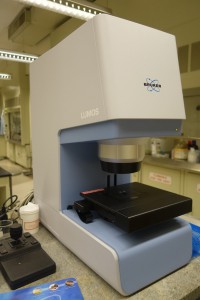Other Equipment Available to All Researchers at Rutgers-Camden. (There is no user fee for all Rutgers-Camden instruments)
 Material Characterization: AFM (Bruker, MM-8), Labcono freeze-dry instrument, Cary 100 UV-Vis Spectrophotometer, Excalibur Series Bio-Rad, Horiba X-ray Fluorescence Analyzer MESA-50, Cary Series UV-Vis-NIR Spectrophotometer, and Horiba Fluorolog TCPC
Material Characterization: AFM (Bruker, MM-8), Labcono freeze-dry instrument, Cary 100 UV-Vis Spectrophotometer, Excalibur Series Bio-Rad, Horiba X-ray Fluorescence Analyzer MESA-50, Cary Series UV-Vis-NIR Spectrophotometer, and Horiba Fluorolog TCPC
Chemical Characterization: HyperIon 3000 IR with Vertex 70v, Agilent Technologies HPLC 1260 with Fluorescence, UV Lamp and temperature controller capabilities, Brukers Ascend 400 NMR, Agilent Technologies 6410 Triple Quad LC/MS, Brukers Scion 456-GC/MS/TCD/FID with a Pyroprobe 5000 Series, Bruker Impact HD UHR-TOF Systemand an Agilent 6550 iFunnel Q-TOF LC/MS System, and NMReady 60 by Nanalysis Corporation.
Light and Electron Microscopy: The CCIB common microscopy facility is composed of a Lieca fluorescence dissecting microscope, a LEO scanning electron microscope (SEM) with X-ray for elemental analysis, and a Zeiss EM 902 transmission electron microscope (TEM) with sliding microtome, vibratome, and various sample preparative equipment.
Laser Laboratory: It includes confocal fluorescence microscope with photobleaching capability (Leica TCSSP8) and ps/ns-laser spectrum.
Atomic Force Microscopy and Dynamic Light Scattering: Atomic Force Microscopy (Asylum, MFP-3D) and the Dynamic Light Scattering (Malvern, Zetasize).
Protein work: A Brinkman polytron fitted with a micro-tip probe for preparing cell extracts. The lab has 5 mini-gel and 4 full-sized electrophoresis rigs for SDS-PAGE. Gel transfers are done at 4° C on an 11 x 17 cm IDEA scientific GENIE blotting apparatus. A 12 ft2 of deli refrigerator space dedicated to dialysis, chromatography columns, and automated fraction collection.
Growth chambers: A 400 sq. ft. common laboratory space containing 6 AR75L growth chambers in the Science Building.
Electrochemical instrumentation: Bipotentiostats electroanalyzer (Pine Instruments), CH Instrument 660.
Chemical Composition: Agilent ATR-FTIR with Diamond crystal STEP Scan Dual detector FTS600 FTIR connected to an UMA 500 IR Microscope with a MCT detector with Ge ATR crystal; a Varian 700 MHz VNMRS system equipped with a 5 mm H,F {C} probe or a 5mm C-P {H,F} probe, both of which utilize Z-axis magnetic field gradient coils; an Agilent Triple Quadrupole High Performance Liquid Chromatography-Mass Spectrometer, Q-TOF Mass Spectrometer (Bruker).
Computing Cluster: The CCIB cluster, named Golova, has shared backup and archiving capability using a Tandberg StorageLibrary T40+, LTO-5 tape drive, with 40 tape slots, and a compressed capacity using 40 tapes for 60TB. Additional capacity is possible by adding (tapes with a capacity of ~1.5TB) and additional tape libraries. The management software is BRU Server Backup Network Edition w/ 25 clients. One client license is used to backup the cluster storage daily while an additional two client licenses will be used to backup the instrument and the workstation in the lab each day, too. Once a research project is complete and data is not in use regularly, it will be possible to create archive tapes for shelf storage. Each tape used for archival storage will be made in duplicate and stored separately according to tape manufacturer recommendations for long-term archiving. The tape storage cases will be shared and stored in a climate-controlled, secure location. If requested, an archive can also be made on a standard data disk and stored in a long-term storage case similar to what is done for tapes. The difference is that the tapes last longer and are more reliable whereas disks can be readily accessed by any desktop or server today. The archive media will be tested at least once per year for any read errors. If errors are found a new backup archive will be created from the second tape archive.